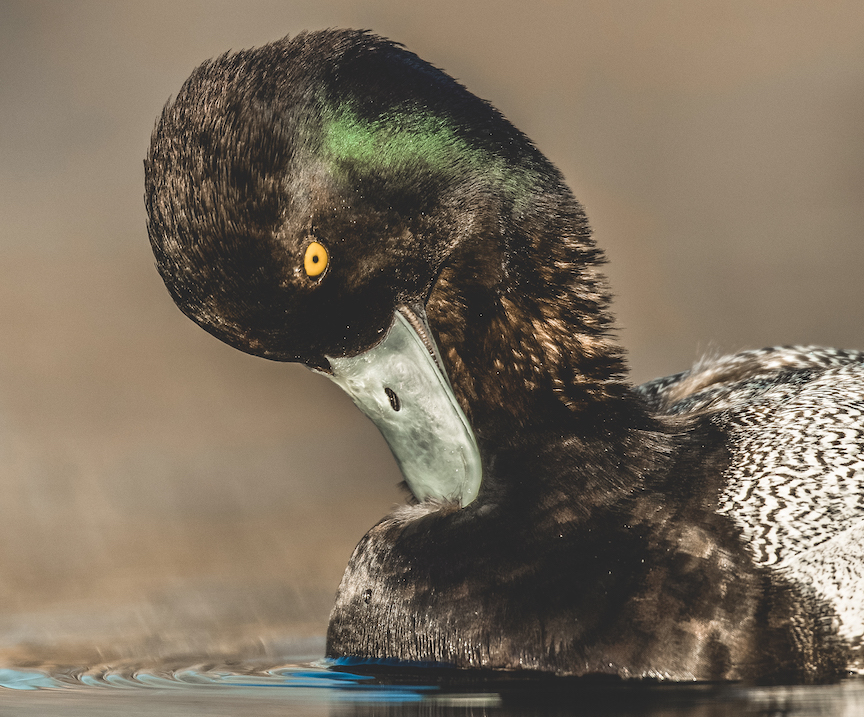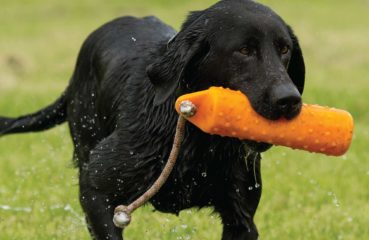The Greater Scaup is a Diving Duck with Coastal Hunting Opportunities
The greater scaup (Aythya marila) is the only circumpolar diving duck, meaning it breeds in far northern latitudes across North America, Europe, and Asia. Its very close cousin, the lesser scaup, is extremely similar-looking in most respects and requires a close examination to tell the difference. Collectively, scaup are often called “bluebills” due to the color of their bills. Scaup are very gregarious birds, often forming gigantic flocks called rafts in the winter.
Description and Life History of the Greater Scaup
The greater scaup is roughly 18 to 20 inches long and weighs in at about 2 pounds (NatureServe 2020). Breeding drakes have dark heads and necks, a finely mottled gray back, pure white sides, and a dark tail end. Their heads display a beautiful iridescent green in the right light conditions, which is accented by its bright yellow eyes and pale blue, black-tipped bill. While flying, all plumages have a bold white wing stripe (speculum) that extends almost to the tip of the wing (All About Birds 2020). Hens have yellow eyes too, but are uniformly light brown (perhaps a little darker brown on the head), with a patch of white surrounding the bill. The differences between greater and lesser scaup are so slight that it often takes a lot of experience to correctly tell them apart. Greater scaup drakes are larger and have rounded heads, while lesser scaup are smaller and have more pointed heads. And in full breeding plumage, greater scaup drakes show an iridescent green on their heads, while lessers have an iridescent purple.

The greater scaup has no issues gathering with other diving ducks. During migration and over the winter, it may form huge flocks that number in the thousands. In late winter, greater scaup start forming pairs after males display for hens. Drakes bow their heads, dip their bills into the water, flick their wings, and whistle to the female. Hens build nests in depressions on islands, along shorelines, or on floating vegetation, using dead plant material and down to line it (National Audubon Society 2020). Scaup may even build nests in close proximity, forming a sort of colony. After breeding, drakes generally gather on lakes with good food supplies and cover to molt and replace their feathers. Females typically lay 5 to 11 brown/olive-colored eggs and incubate them for 23 to 28 days (All About Birds 2020). Hens lead their broods to open water shortly after hatching, and broods may combine with others. The ducklings are capable of flying by 45 days of age (National Audubon Society 2020).
Like its cousin the canvasback, greater scaup are divers – very good ones, too. They may dive down to 23 feet to retrieve invertebrates and plant materials to eat (All About Birds 2020). Since greater scaup tend to inhabit coastal areas over the winter, mollusks (e.g., snails, mussels, clams, oysters, scallops, etc.) and aquatic insects are often targeted (NatureServe 2020; National Audubon Society 2020). They open their bills in soft muddy bottom substrates, and paddle forward while “combing” for food. They also eat seeds, leaves, stems, and roots/tubers of aquatic plants, including sedges, grasses, pondweeds, muskgrass, and wild celery (NatureServe 2020; National Audubon Society 2020).
Common predators that will target eggs, ducklings, or adult birds include gulls, ravens, foxes, skunks, and raccoons, although pike may also eat small ducklings if they occur in freshwater systems (All About Birds 2020).
Range and Habitat of the Greater Scaup
The greater scaup has a large range globally. In North America, they breed in Alaska, across northern Canada (including around Hudson Bay), and out to the Atlantic Ocean in Newfoundland. They generally start arriving at far northern breeding areas (coastal tundra of the Arctic and sub-Arctic) by May or early June. However, they spend their winters along the Pacific Coast (from southeast Alaska to California), Great Lakes, or Atlantic Coast (from Canada to the Gulf Coast) (NatureServe 2020). Individuals may overwinter on opposite sides of the continent in alternate years, depending on which flock they join during migration.
During the breeding season, greater scaup tend to occupy freshwater ponds, lakes (especially on islands), and treeless marshes or bogs in the far north tundra (NatureServe 2020; National Audubon Society 2020). During the winter, though, they usually form huge flocks and key in on large open inland lakes and rivers, protected bays, lagoons, and coastal estuaries (NatureServe 2020; National Audubon Society 2020). Roughly 60 to 70 percent of the North American population spends the winter along the Atlantic Coast and about 20 percent spend the winter along the Pacific Coast (All About Birds 2020).
Conservation Issues for the Greater Scaup
The greater scaup is listed as globally secure and of Least Concern by the IUCN Red List (NatureServe 2020). The global breeding population is estimated at about 780,000 birds, but their population is declining quickly (All About Birds 2020). A common issue is habitat loss in northern breeding areas and along shorelines and coastal areas due to human development. Another concern for the scaup (being bottom-feeders) is pollution and bioaccumulation. Roughly 70 percent of the greater scaup population within the Atlantic flyway overwinters in heavily urbanized areas, where contaminants such as DDE, PCBs, or heavy metals (e.g., mercury, selenium, etc.) occur, and which have also been found in scaup tissues and eggs (All About Birds 2020). Selenium is also ingested from invasive zebra mussels in the Great Lakes, which accumulates in the ducks. Over time, these can be lethal or may actually sterilize hens so that they cannot reproduce, although more research is needed on this topic. Hunters harvested about 69,366 greater scaup annually between 2012 and 2016, which doesn’t have much of an effect on the population (All About Birds 2020). Last, fishing nets can be a hazard to diving ducks, and greater scaup do get tangled in them occasionally, which usually leads to drowning.
Hunting Opportunities for the Greater Scaup
Because greater scaup rarely migrate across interior states and instead stick to the coastlines, it can be tough to hunt them outside the Pacific or Atlantic flyways, but you can occasionally see some in the Mississippi flyway near the Great Lakes. Lesser scaup, on the other hand, often migrate through and offer more opportunities inland. If you’re looking to break into hunting bluebills, consider seeking out a waterfowl outfitter – it can pay off in not only ducks harvested, but key lessons learned that will help you in the future.
Equipment and Bag Limits
As usual, you will need to have the basics for duck hunting, including a hunting license/federal duck stamp, a shotgun (12-gauge), non-toxic shotgun shells, waterfowl camo clothing, a blind, and some decoys. Many intentional scaup hunters choose to hunt on open water from a layout boat concealed with a blind, but land-based blinds can work well too. You may need a few dozen decoys to really interest larger migrating flocks. The current daily bag limit for scaup (greater or lesser, combined since their field identification is tough) is three birds.
Greater Scaup Hunting Techniques
Scouting before a hunt is always important for success. Try glassing some likely spots at dawn to see where the divers are actively feeding, particularly if it’s adjacent to a spot you can hunt from. If you don’t feel comfortable hunting from the water or you simply don’t have a suitable boat, try positioning your blind out on a point to get access to more water for the decoys. As mentioned, the bigger the spread, the better off you likely will be. Try putting out at least three dozen decoys if you have them, focusing on drakes more than hens (since they are so flashy from the sky). And don’t be afraid to toss some other diving duck decoys out either. When using so many decoys, gang rigs in long parallel lines can allow you to quickly set a raft up slightly upwind of your boat or blind. By running a single long line of decoys downwind, you can create a runway of sorts to guide the ducks in. Divers often approach spreads low over the water and fast, so be ready when they come in.
For divers, your priority should be to set up in a good location and rely on your decoy spread. But while calling to puddle ducks like mallards or teal is more common, you can also call to divers like the scaup. Hens often make a raspy barking call, but common diver calls that make low-pitched growls, “brrrr” sounds, and throaty grumbles can all work. Occasionally, even puddle duck comeback calls can work. So if you find the ducks are circling but not committing to your spread, try blasting out a few calls and see what happens. Good luck with the bluebills!
Sources
All About Birds. 2020. Greater Scaup. Accessed at: https://www.allaboutbirds.org/guide/Greater_Scaup/id
NatureServe. 2020. NatureServe Explorer: An online encyclopedia of life. Accessed at: http://explorer.natureserve.org
National Audubon Society. 2020. Guide to North American Birds. Accessed at: https://www.audubon.org/field-guide/bird/greater-scaup
Last modified: January 24, 2021











Great article! One suggestion: you might want to edit “The current daily bag limit for scaup (greater or lesser, combined since their field identification is tough) is three birds.” This varies by state and district within state.